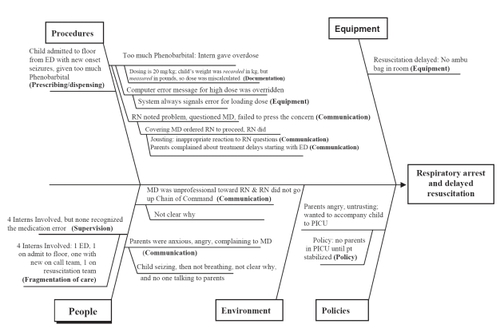Figures & data
Table 1 Sequence of events in this project
Figure 1 A hypothetical 6 month old female weighing 15 1/2 pounds was admitted with a diagnosis of seizures. The cause-and-effect diagram depicts aspects of her care and the adverse outcome following a medication error. Risk management code categories are bolded in the diagram. The elements of the case are as follows: RS, a 6 month-old healthy female, was admitted to the hospital with new onset seizures. An intern was instructed by an attending neurologist, Dr. Neurologist, to administer 20 mg/kg of phenobarbital. The intern noted the weight from the ED triage sheet (recorded as 15.5 kg) and ordered 310 mg of phenobarbital IV. An error message was generated by the computer order entry system, but was overridden by the intern (error messages are always given for loading doses - the system was programmed to check maintenance doses only). Because the on-call period was ending, the intern checked out to the new on-call team. Shortly after the new shift began, RS’s nurse received the loading dose from the pharmacy and was concerned by the amount (310 mgs). She saw the covering intern finishing a note and said “sure is a large dose of phenobarbital for such a small child.” The intern replied, “Loading doses are supposed to be large; the parents have already complained to me about the delay. Get the drug in — NOW. I am NOT answering to a d*** nurse.” The phenobarbital was given and RS stopped breathing. A general code was called. No ambu bag was found in the room, so another intern began mouth to mouth resuscitation. The parents witnessed the event. RS was intubated and transferred to the PICU, where her parents insisted on accompanying her. A staff member refused them entry, explaining that the PICU protocol did not allow parents to be admitted until the patient is stabilized.

Table 2 Adverse outcomes associated with case files